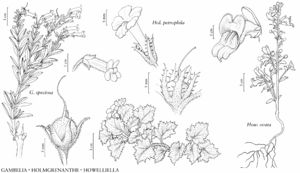Gambelia
Proc. Acad. Nat. Sci. Philadelphia 4: 7. 1848.
| Taxon | Illustrator ⠉ | |
|---|---|---|
 | Gambelia speciosa Holmgrenanthe petrophila Howelliella ovata | Barbara Alongi Barbara Alongi Barbara Alongi |
Shrubs. Stems pendent or erect, glabrous or glandular-hairy. Leaves persistent, cauline, whorled [opposite]; petiole present; blade not fleshy, not leathery, margins entire, distal leaf-blade not needlelike or scalelike. Inflorescences terminal [axillary], racemes; bracts present. Pedicels present; bracteoles absent. Flowers bisexual; sepals 5, basally connate, calyx radially symmetric, campanulate, lobes lanceolate [ovate]; corolla red, bilaterally symmetric, bilabiate and personate [open-throated], tubular, tube base not spurred or gibbous, lobes 5, abaxial 3, adaxial 2; stamens 4, basally adnate to corolla, didynamous, filaments basally hairy, distally glabrous; staminode 0; ovary 2-locular, placentation axile; stigma 2-lobed. Fruits capsules, dehiscence loculicidal. Seeds 40–80 [–120], dark-brown to black, ovoid [oblong], wings absent. x = 15.
Distribution
Calif., w Mexico
Discussion
Species 4 (1 in the flora).
Gambelia is defined by its shrubby habit, whorled (rarely opposite) leaves, and red corollas. Generic delimitation has varied considerably with species placed in Gambelia (D. A. Sutton 1988; E. Fischer 2004) and Saccularia Kellogg (W. Rothmaler 1943) or combined with South American species in Galvezia Dombey ex Jussieu (P. A. Munz 1926). Most authors recognize Gambelia as exclusively North American and Galvezia as comprising species in South America and the Galapagos Islands (Sutton; Fischer). Gambelia speciosa was included in molecular phylogenetic analyses of Antirrhineae by M. Ghebrehiwet et al. (2000) and M. Fernández-Mazuecos et al. (2013). The latter investigation demonstrated strong support for recognition of a North American Gambelia nested in an Antirrhinum clade distinct from South American species of Galvezia nested within a Galvezia clade. The extent of isozyme, morphological, and molecular divergence (Sutton; W. J. Elisens and A. D. Nelson 1993; Ghebrehiwet et al.) among species in this clade is consistent with recognition of Gambelia for North American species and Galvezia for South American species.